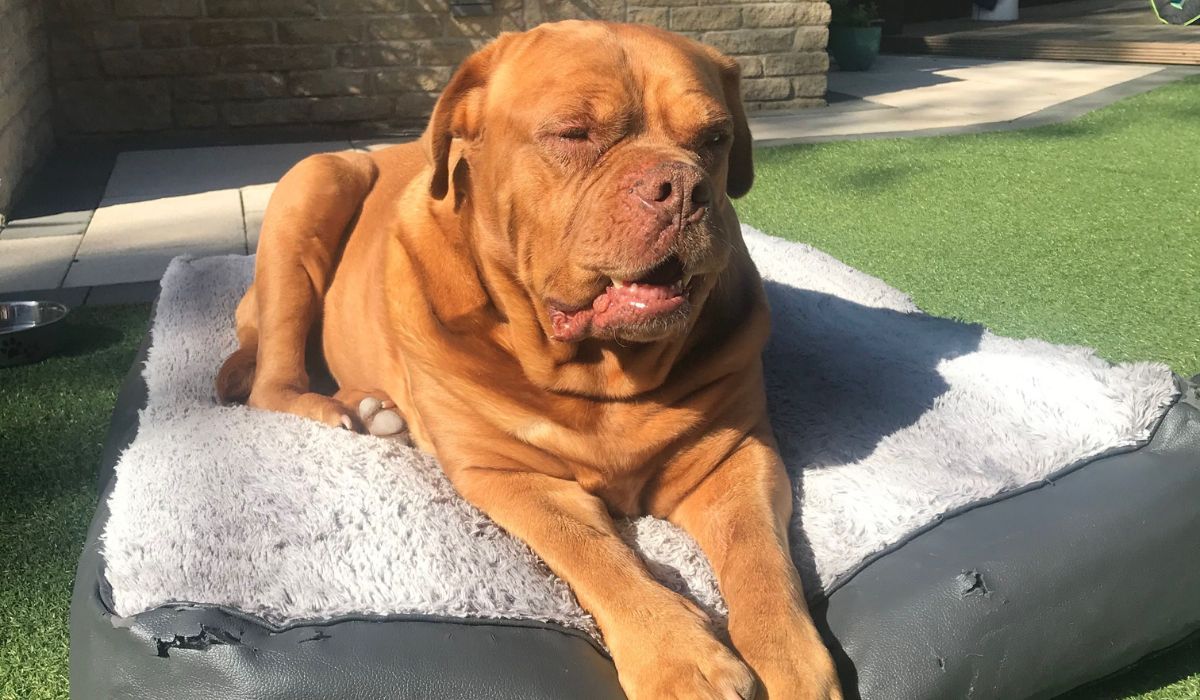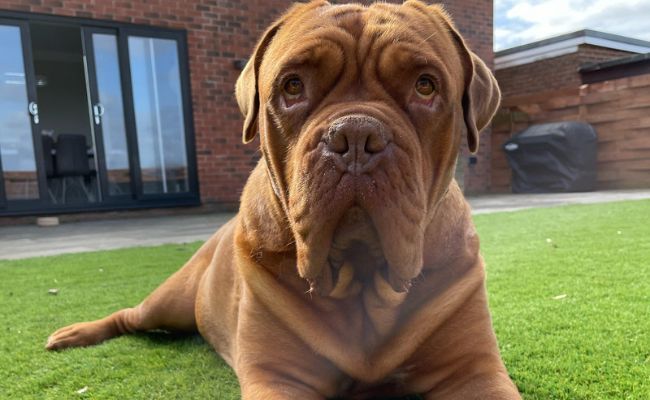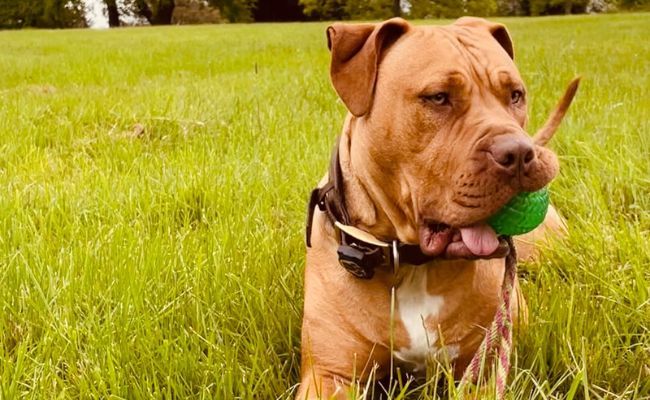
Dogue de Bordeaux
19 July 2023
Let's talk about... Dogue de Bordeaux: what are they?
- The Dogue de Bordeaux, also known as the Bordeaux Mastiff or French Mastiff, is a big, but gentle dog originating from France.
- They have a long history, and were primarily bred for tasks such as guarding, hunting, and pulling carts.
- A famous member of the breed was Hooch from the 1989 film Turner and Hooch.
- With their massive heads and muscular bodies, they are known for their impressive appearance.
- They are also known for making lots of drool and it can end up everywhere!
- Male Dogue de Bordeaux can reach a height of 60 to 68 centimetres, while females typically stand between 58 and 66 centimetres.
- In terms of weight, males can weigh between 54 and 65 kilograms, while females generally weigh between 45 and 54 kilograms.
- The average life expectancy for this breed is around 8 to 10 years.

What is the temperament of Dogue de Bordeaux like?
- Dogues de Bordeaux are generally loyal, protective, and affectionate.
- They are known for their calm and patient nature, making them excellent family companions.
- They form strong bonds with their owners and are often gentle and tolerant with children if socialised with them from a young age.
- However, due to their large size and strength, supervision is recommended when they interact with younger children, as even the most gentle big pooch may not realise their own strength.
- If brought up with other pets they can be comfortable with them, but in some cases they can be a bit dominant towards other dogs.
- These dogs can be wary of strangers, displaying a natural guarding instinct.
- Socialising them early is crucial to ensure they are well-adjusted and comfortable in various situations.

How much exercise do Dogue de Bordeaux need?
- Dogues de Bordeaux have moderate exercise needs and typically require around 30 to 45 minutes of exercise per day.
- While they are not overly active dogs, regular exercise is essential to keep them in good physical condition and mentally stimulated.
- When it comes to Dogue de Bordeaux puppies, it's important to be cautious with their exercise regimen. Due to their rapid growth and development, excessive exercise can put strain on their developing joints and bones.
- Although there is no scientific basis to the 5 minutes of exercise per month of age “rule”, it can be a guide to make sure you don’t over-exercise your puppy, which is especially important in giant breeds. Bordeaux puppies could get 5 minutes of exercise per month of age once or twice a day, but reduce that if it seems too much.
- As well as walks though fun, mental stimulating games can entertain and tire an active pup.
- As they mature and their bones and joints mature, exercise duration can gradually increase.
- They typically reach full exercise capacity at an adult level around 12 to 18 months of age.

Do Dogue de Bordeaux need a lot of grooming?
- Dogues de Bordeaux have a short and dense coat that requires minimal grooming.
- Weekly brushing with a soft-bristle brush or a grooming mitt helps to remove loose hair and keep their coat in good condition.
- Additionally, regular cleaning of their facial folds is important to prevent the buildup of dirt and moisture, which can lead to skin infections.
- Bathing them every 1 to 2 months is usually enough to keep them clean.
- Like any dog, regular tooth brushing with a dog-specific toothpaste twice daily is ideal. If you can’t manage that often, just do it as often as you can.

Are Dogue de Bordeaux easy to train?
- Dogue de Bordeaux can be independent and stubborn at times, which can make training a bit challenging.
- They are intelligent dogs, but they may have a more laid-back and less eager-to-please attitude compared to some other breeds.
- Consistent and positive training methods work best with Dogue de Bordeaux. Use reward-based techniques, such as treats, praise, and play, to motivate and engage them during training sessions.
- It's important to establish yourself as confident while maintaining a gentle and patient approach.
- Early socialisation and obedience training are crucial to ensure they grow into well-behaved and well-mannered dogs.
- Remember to keep training sessions short, interesting, and varied to prevent boredom and always train with positive reinforcement!
- Proper training is necessary to establish boundaries and prevent any dominant or aggressive behaviour.

What do Dogue de Bordeaux eat?
- Feeding your Dogue de Bordeaux a balanced and nutritious diet is vital for their overall health and well-being.
- High-quality commercial dog food specific for large or giant breeds and should be fed twice a day, which can help reduce the risk of bloat compared to feeding once a day.
- As puppies they should be fed 3-4 times a day, gradually reducing to twice a day at 6 months old. They should be on a large or giant breed puppy food until they are 12-18 months old, depending on the brand of food. Your pet food supplier or vet can advise.
- Don’t overfeed or add unnecessary supplements to your puppy’s diet, as you want them to grow slowly, to reduce the risk of bone development problems from growing too fast.
Are Dogue de Bordeaux healthy?
Dogue de Bordeaux is generally a healthy breed, but like any dog, they can be prone to certain health conditions. Some potential health concerns to be aware of include:
Bones and Joints
- Elbow Dysplasia - this condition is where there is an issue with how the bones fit together at the elbow joint
- Hip Dysplasia - a condition where the thigh bone and pelvis do not sit together properly at the hip joint
Eyes
- Cherry eye - this is when there is popping out of the third eyelid gland
- Ectropion - with this condition the eyelid rolls out, which can expose the eye to dryness
- Entropion - this is where the eyelids roll in, causing eyelashes to rub onto the surface of the eye
Heart
- Aortic Stenosis - a narrowing of the aortic valve of the heart
- Dilated Cardiomyopathy (DCM) - a disease of the heart muscle causing the heart ventricles to get larger
This list is by no means comprehensive, if you have any concerns about the health of your dog, or if you want to discuss further if a Dogue de Bordeaux is right for you, consult with your vet.
BorrowMyDoggy loves Dogues de Bordeaux
BorrowMyDoggy has 853 Dogue de Bordeaux members
Information on this page should never replace advice given by your veterinarian. Potential health issues presented are given as a guide only and are not meant to be comprehensive. If you ever have any concerns about your dog’s health contact your local vet.
Large Working Dog Breeds
Know someone who'd love this?
Hey there!
Want to hear about a different kind of dog care that both you and your dog will love?
Or perhaps you're a dog lover who can't have one of your own right now?
We have the pawfect solution, BorrowMyDoggy!
How it works
Old Tyme Bulldog
Learn facts about the Old Tyme Bulldog dog breed from the BorrowMyDoggy community in our Old Tyme Bulldog guide!
Read article
Norwegian Elkhound
Learn facts about the Norwegian Elkhound dog breed from the BorrowMyDoggy community in our Norwegian Elkhound Terrier guide!
Read article
Dandie Dinmont Terrier
Learn facts about the Dandie Dinmonth Terrier dog breed from the BorrowMyDoggy community in our Dandie Dinmonth Terrier guide!
Read article
American Bulldog
Learn facts about the American Bulldog dog breed from the BorrowMyDoggy community in our American Bulldog guide!
Read article